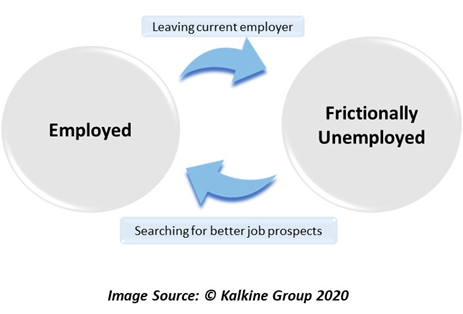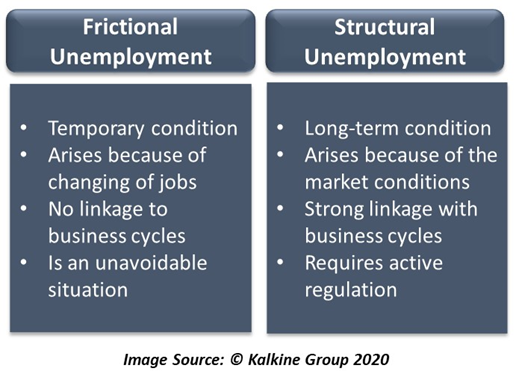What is Frictional Unemployment?
Frictional unemployment is the type of unemployment which occurs when the population that is capable to work, is shifting between jobs voluntarily. An individual is said to be frictionally unemployed when he is looking for a new job or is changing from one job to another.
Frictional unemployment may not always signify an unhealthy economy. It is a part of natural unemployment and cannot be avoided. Time delays in finding a new job are not unusual and can be seen even in a skilled workforce.
This type of unemployment is voluntary and involves the workforce that possesses the skills and ability to work. However, that workforce chooses to stay unemployed in hopes of finding a better job. Under the scenario of a recession, workers would want to hold on to their current jobs rather than look for a new one. Thus, frictional unemployment tends to remain stable in times of a recession.

Why do employed people decide to leave their jobs and search for new ones?
There are a variety of reasons why employed people feel the need to shift to a new job. Sometimes people are not be satisfied with their job and want to switch to another job for greater exposure, career expansion or monetary increase.
On other occasions, people might feel the need to take a sabbatical from work and improve on their skill set. It is also possible that they may want to stay at home because of health reasons or to take care of someone.
The frictionally unemployed workforce also includes students who have graduated and are looking for jobs. Some of them can find a job immediately while others may take time to find one or to decide whether to work or to pursue higher education.
What is the linkage between frictional unemployment and the economy?
There is no linkage between frictional unemployment and the business cycle that exists in the economy. The business cycle fluctuations do not impact the level of frictional unemployment. This is so because the voluntary unemployment observed among the workforce depends on their personal preferences rather than on the health of the economy.
This is exactly the reason why frictional unemployment cannot be considered particularly harmful for the economy.
From an alternative point of view, it can be argued that high levels of frictional unemployment could mean that more and more of the workforce is shifting towards better job prospects. This could mean higher productivity in the future and an increase in consumer demand as salaries of the employed people rise.
From the perspective of the employers, higher level of frictional unemployment seems to be good news. For the firms, this indicates an economy with a sizeable workforce that is skilled and educated enough to be hired. Therefore, firms might perceive this as a potential situation to gain from.
However, from the point of view of the unemployed, it might be difficult to manage expenses. It can be argued that people choose to leave their jobs when they have enough savings to depend on. However, in the rare event of someone quitting their job spontaneously, there might be an off chance that there is nothing for them to fall back on.
Therefore, it is obvious that a frictionally unemployed individual would try to cut down on expenses. This means that a high level of frictional unemployment could also lead to a lack of demand in the economy.
How is frictional unemployment different from structural unemployment?
Structural unemployment refers to a more long-term kind of unemployment which exists when people who are skilled and willing to work are not able to find a job. The lack of appropriate jobs for them arises because of the market conditions rather than because of their own unwillingness.
Structural unemployment has a strong connection to business cycles. When the market conditions are bad, then the workers may find it difficult to get a suitable job.
On the other hand, frictional unemployment is considered to be a temporary condition where there is a future possibility of workers getting employed. An economy that sees only frictional unemployment and no other kind of unemployment would be considered fully employed. Therefore, frictional unemployment is adjusted while calculating the full employment rate.
However, structural unemployment is not adjusted, and it is a concerning situation for the economy. A high level of structural unemployment could give various hints about the state of the economy. However, the same is not true for frictional unemployment.
Structural unemployment requires active regulation and government interference. If appropriate measures are not taken, then it may become severe for an economy. It can last for a very long time and can eat up the buying capacity of the consumers. Therefore, structural unemployment is a much more severe situation than frictional unemployment.

How can frictional unemployment be tackled?
Many policies which are adopted under normal circumstances to fight unemployment would not work when governments try to reduce frictional unemployment. Therefore, other measures might need to be adopted:
- Matching the workforce with appropriate jobs: As workers find the type of jobs that they are comfortable in and can enjoy doing, they become less prone to quitting. Therefore, workers need to be matched with the appropriate type of jobs for them. The government may try to invest in a platform that connects job seekers with employers. This way, there can be better outreach for both.
- Reducing unemployment benefits: Since frictional unemployment depends on the willingness of the worker, it can be influenced through the availability of unemployment benefits. This has both positives and negatives attached to it. However, this is one of the few solutions to fight frictional unemployment if it starts to be an issue of concern for the government.
Expansionary monetary policies might harm the economy in the case of frictional unemployment. Workers, suspecting better job prospects under monetary expansion, would further quit their jobs or would continue to stay unemployed. Therefore, conventional policies may not give desired results.
 Please wait processing your request...
Please wait processing your request...